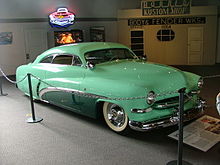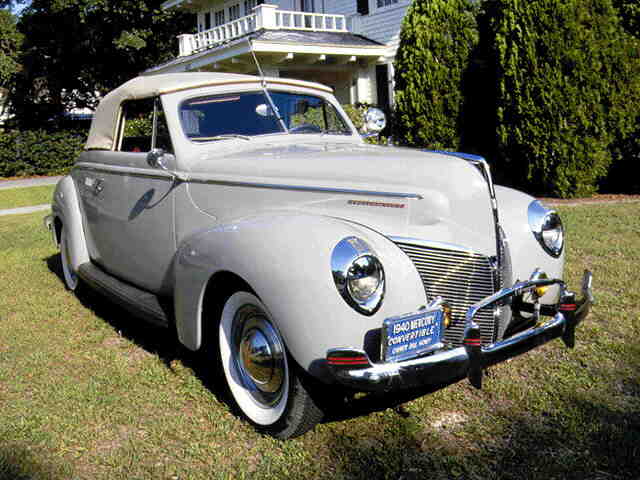Thursday, December 25, 2014
Wednesday, December 17, 2014
Monday, December 1, 2014
Mustang Alternative: 1967 Mercury Cougar
![[Image]](http://barnfinds.com/wp-content/uploads/2014/11/1967-Mercury-Cougar-584x365.jpg)
America has had an on-again, off-again love affair with the Mustang since day one and in recent years they have become extremely popular, but with popularity comes inflated prices. Over the past few years I have watched the original Pony Car slowly climb in price, from being down right affordable to simply overpriced. As Fastbacks and GTs make their steady climb out of affordability, I’ve been looking for cheaper alternatives. Sure you can do like we did and get a base car with an inline six, but if you want V8 power you might be better off looking elsewhere. Thankfully there are a few alternatives that might not look all that similar, but can offer the same experience for a lot less coin. If you must have the real deal, you could buy a rough project like the ‘64.5 Mustang that Jim S. found here on eBay. Or you could go with this 1967 Mercury Cougar which can be found here on eBay for $3,950.
For more information Click Here.
Source: barnfinds.com
Wednesday, November 5, 2014
Monday, November 3, 2014
1962–1963 Mercury Meteor

For 1962, Mercury marketing decided that the Monterey nameplate had better consumer recognition than the Meteor moniker as far as full-sized vehicles were concerned (despite the fact that Meteor outsold Monterey), and instead assigned the Meteor name to a new line of mid-sized cars based on the Ford Fairlane which, in turn, was based on a long-wheelbase version of the Ford Falcon chassis. This smaller, mid-sized Meteor filled the product gap between the full-sized Monterey and the compact, Ford Falcon-based Mercury Comet.
Riding the Fairlane’s 116.5 wheelbase, the 1962 Meteors wore unique rear quarter panels that mimicked the Monterey's jet-pod tail lights. The base Meteor and better-trimmed Meteor Custom were available in two- and four-door sedans. The Meteor S-33 was a specially trimmed two-door sedan featuring premium exterior trim and interior appointments including bucket seats, and a center console. Its styling and features were similar to the Fairlane 500 Sports Coupe.
For 1963 Meteors received an annual trim update and the addition of two body styles, a four-door station wagon and a two-door hardtop coupe. The four-door station wagon was added to both the Meteor series and the Meteor Custom series. In the Meteor Custom series the station wagon was referred to as the Mercury Country Cruiser and featured simulated wood-grain trim on the exterior. The hardtop coupe was added to the Meteor Custom and Meteor S-33 series. The hardtop coupe replaced the 2-door sedan in the Meteor S-33 series, as had the Fairlane Sports Coupe.
The base Meteor engine was a 170 cubic inch displacement inline 6-cylinder engine with a 1-barrel carburetor 101 horsepower (75 kW) @ 4000 rpm. Optional engines included a 221 cubic inch V-8 with 2-barrel carburetor that generated 145 horsepower (108 kW) and a 260 cubic inch V-8 with 2-barrel carburetor that generated 164 horsepower (122 kW). A three-speed manual transmission was standard. Overdrive and Merc-O-Matic automatic transmissions were options. A 4-speed manual transmission became an option for 1963.
Sales of the mid-sized Mercury Meteor were disappointing and the model was discontinued at the end of the 1963 model year.
Source: wikipedia.com
Wednesday, October 1, 2014
Tuesday, September 2, 2014
Sunday, August 31, 2014
Monday, August 4, 2014
Friday, August 1, 2014
Monday, July 7, 2014
Wednesday, July 2, 2014
Hirohata Merc
The Hirohata Merc is a 1950's custom car, "the most famous custom of the classic era". Setting a style and an attitude, it had a "momentous effect" on custom car builders, appeared in several magazines at the time and has reappeared numerous times since, earning an honorable mention on Rod & Custom's "Twenty Best of All Time" list in 1991. The impact may be measured by the fact that, after more than fifty years and numerous owners, it is still known as "the Hirohata Merc".
Construction
Constructed in 1953 for Bob Hirohata, it was designed and built by George and Sam Barris, assisted by Frank Sonzogni. It started out as a 1951 Club Coupe. Nosed, decked, and shaved, the top was chopped four inches in front and seven inches in back, and the vertical B-pillar was reshaped so that it curved forward. The rear window had its posts removed, and was raked steeply forward, requiring a new roof piece to be fabricated. Side trim was replaced with that from a 1952 Buick (the spears), augmented by grille teeth from a 1952 Chevrolet (three per side) and functional scoops. The front wheels are fitted with traditional sombrero ('47-'51 Cadillac) hubcaps.Skirts were added, fitting flush. Three '51 Ford grills were used to custom-fabricate one, and the bumper was fitted with dagmars.
hield, a very common customizers' trick in that era, rather than a one-piece windshield, which was available on the '53 Merc. He added Appleton spotlights, frenched the headlights (which were fitted with '52 Ford rings), and added '52 Lincoln Capri taillights. The exhaust pipes were routed out through the rear bumper, beneath the taillights, and a pair of radio antennae were frenched into the rear quarter panels.
The Hirohata Merc was painted in two shades of green, a total of thirty coats, which were applied by Junior Conway. The interior was upholstered with tuck-and-rolled naugahyde. The dash, seats, and headliner were white with dark green inserts, matching the exterior lower body color (below the Buick spears).
Later changes
Hirohata later replaced the original Mercury flathead engine with a transplanted Cadillac engine, creating the nickname "Mercillac" ("merk-ill-ack"), in the fashion of rodders of the period, who in the same way created Fordillacs and Studillacs.In 1955, the Merc made an appearance in the film Running Wild, for which it was painted gold over the original ice green.
Hirohata sold the Merc, and the car changed hands several times. It was eventually owned Jim McNiel, who used it as a daily driver for years, then placed it into storage. Ultimately, McNiel restored the Merc to her original configuration. The restoration was done by Hershel "Junior" Conway at Junior's House of Color.
Magazine appearances
- Hot Rod March 1953
- Motor Trend March 1953
- Rod & Custom October 1953
- Trend Book 109 Custom Cars 1954 Annual
- Rodding and Re-styling January 1956
- Trend Book 143 Restyle Your Car
- Rod & Custom August 1989
- Road & Track August 2004
- Trend Book 133 Custom Cars 1957 Annual
- The Big Book of Barris
- Automotive restoration
- Kustom (cars)
- Lead sled
- Von Dutch
- Favorite 50 Rods & Customs
- "'50s Hirohata Merc Photo's album - including article from Rod & Custom October 1953"
- Jalopy Journal
- Barris.com
- Kustomrama
Tuesday, July 1, 2014
Tuesday, June 24, 2014
Paul Bragg Livingston Merc
Every body panel on Frank Livingston’s ’49 Mercury was reworked by metal master Paul Bragg. This article shows what was needed to create this styling masterpiece.
Paul
Bragg has been building custom cars for many decades. He is world wide
known for his fantastic metal working skills and excellent taste in
Custom Car design. Paul combines his metal working skills with an very
good eye for proportions, lines and style. Allowing him to
modify virtually anything he feels is needed for the perfect custom.
Paul has restyled a lot of ’49 – ’51 Mercury’s, and each of them
styled differently, and chopped in way that fits that particular
restyled car the best. We will devote several articles about Paul, and
the wonderful Custom Cars he creates, stay tuned. This first article is
about an extensively restyled 1949 Mercury Paul built for Frank
Livingston.
 Before
starting to cut up a car, Paul usually makes a few sketches of what he
has in mind for a particular car. It helps him to see if all the design
elements work together but it also allows the client to see which
direction Paul has planned for them.
Before
starting to cut up a car, Paul usually makes a few sketches of what he
has in mind for a particular car. It helps him to see if all the design
elements work together but it also allows the client to see which
direction Paul has planned for them.Frank Livingston is no stranger when itmcomes to Custom Cars. Ever since the mid 1950′s Frank has owned Custom Cars, some of them were famous, made the magazines and even some covers. He showed his car at many famous car shows. And Frank is still at it today, very active promoting and enjoying Custom Cars. In the early 1990′s Frank had his most restyled custom to date, a ’49 Mercury named “Moon Fire” built by some of the top shops in the field, including Paul Bragg Rods & Customs out of Paso Robles in California.
The top
Frank Livingston approuched Paul Bragg for a new custom based on his ’49 Mercury they discussed what could and needed to be done to the car. Paul had a very clear vision how the car should look. He made several sketches to show Frank what he had mind. What Paul had in mind was not your average “basic” custom job. The sketched showed that nearly every body panel would need to be reshaped to match the sketches. When both approved on how the car should end up looking it was time to start cutting up the Mercury body. Paul started with chopping the top, he removed 4.5 inches from the front and nearly 6 inches from the C-pillars. Paul removed the drip rails, and leaned the B-pillars forward. At the back he removed the stock rear window, and most of the surrounding metal. He used an ’49 Chrysler rear window reshaped the rear quarter windows and hand formed the complete rear portion of the roof and turret panel. The end result is an unique shaped top that flows gently towards the trunk and has perfect proportions from every angle you look at it. The Plymouth rear window fitted better with the trunk changes Paul had in mind for the car. Going for the smoothed look Paul decided the belt line trim had to go as well, and the sharp edge was filled in and smoothed. An old trick the Ayala’s and Barris shops also loved to do.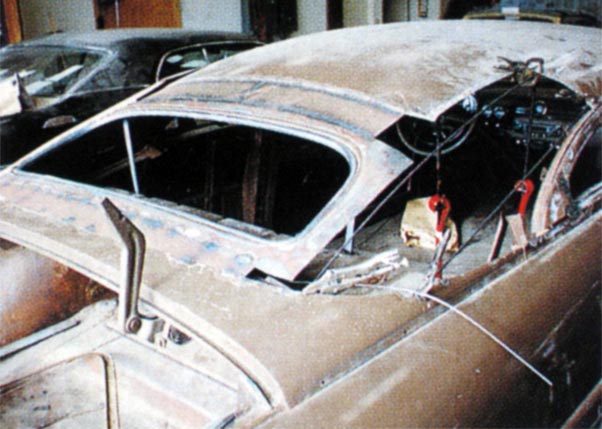 This
photo taken in the early stages shows how Paul incorporated the ’49
Chrysler rear window. And how much new shaped metal was needed to get
the desired look. Also not the sharp edge where the belt line trim used
to be.
This
photo taken in the early stages shows how Paul incorporated the ’49
Chrysler rear window. And how much new shaped metal was needed to get
the desired look. Also not the sharp edge where the belt line trim used
to be. The
metal work on the top portion of the car is all done, and paul is ready
to apply the first coats of primer. Take a close look at the flow of
this top, and notice the molded in and smoothed belt line.
The
metal work on the top portion of the car is all done, and paul is ready
to apply the first coats of primer. Take a close look at the flow of
this top, and notice the molded in and smoothed belt line.The sides
With the top portion of the car in primer it was time to move to the lower parts of the car that needed to be restyled. The front wheel openings were lipped using the wheel opening from an ’55 Plymouth. At the rocker panels Paul created a hand shaped panel to extend this lip from the front wheel opening all the way to rear quarters where it would end at the leading edge of a custom made forward angled scoop. The angle of the scoop is set at the same angle as the B-Pillar. Paul originally planned to update the side trim with a much wider ’53 Mercury unit. And shaped the scoop top leading edge to follow the bottom edge of the side trim closely. At a later stage Frank decided he did not like the heavy trim and asked Paul to add a much thinner unit.Paul wanted flush fitted skirts on the car, but decided they needed to be much longer than on the stock rear wheel opening mercury. So he cut out a little oversized section from the rear quarter panel, he then formed a metal lip to finish the new opening. But before he welded that into place, he used this lip to shape the new flush fit fender skirts first in wire, and later,in sheet metal. Once the skirts were up to Pauls’s standards he welded the lip to the rear quarters. Paul created a set of wonderfully styled larger flish fitting fender skirts.
 The new opening lip for the rear wheel opening was used to shape a wire frame for the new flush fitting skirts.
The new opening lip for the rear wheel opening was used to shape a wire frame for the new flush fitting skirts.  The
metal lip has now been welded to the enlarged and reshaped opening.
Notice the quarter panel scoop and how the angle matches the B-Pillar.
The
metal lip has now been welded to the enlarged and reshaped opening.
Notice the quarter panel scoop and how the angle matches the B-Pillar.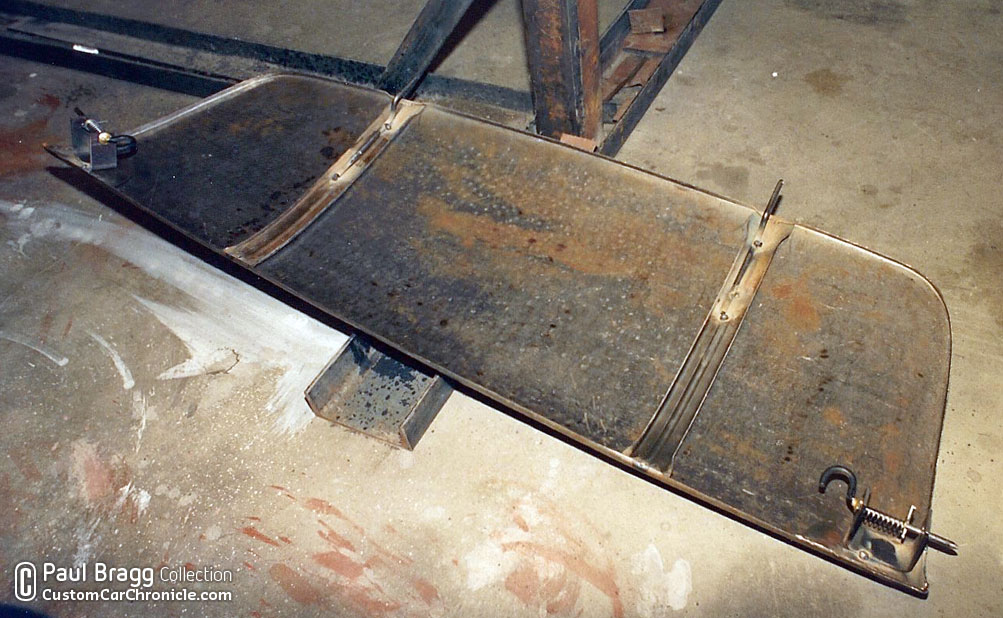 The back side of the hand made passenger side fender skirt.
The back side of the hand made passenger side fender skirt.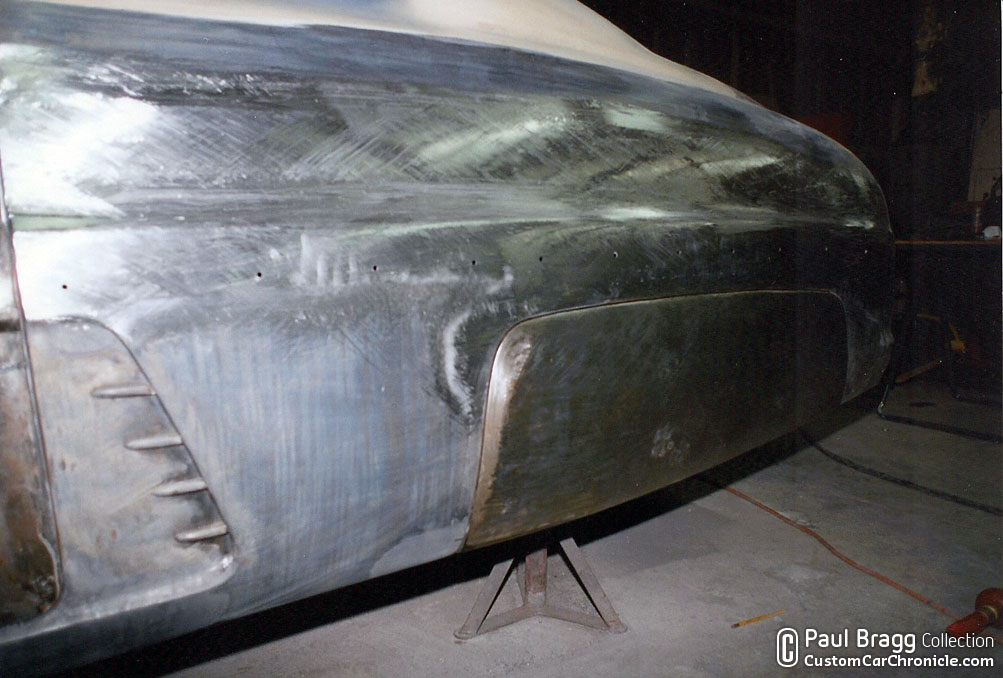 The finished skirts in place.
The finished skirts in place.The rear
Paul then moved further back and started there with the rear bumper. Paul used a 1951 Mercury front bumper and reshaped it to fit flush with the body. He used a narrowed 1955 Pontiac license plate cover and molded that onto the bumper. Next he created a flush fitting splash pan that followed the shape of the bumper including the raised center section. This raised center section would be the base for the recessed section on the trunk The top portion of the recess was shaped into a scoop with similar styling as the quarter panel scoops. The shape of the molded in splash pan was extended to the sides of the body where they would follow the ends pieces of the ’51 Mercury bumper. The Mercury body line extending from the front fenders was extended horizontal towards the rear where it falls down to the bottom on a stock Mercury. This extended section was the base for the hand shaped three part taillights. Paul also moved the so called “dog leg” dip in the doors towards the back of the door. Making the dip much less pronounced. Most
of the hard body work on the rear section is completed in this photo.
The trunk was heavily reshaped with rounded corners and cut out to folow
the shape of the custom bumper. This bumper will fit flush in the new
opening created for it.
Most
of the hard body work on the rear section is completed in this photo.
The trunk was heavily reshaped with rounded corners and cut out to folow
the shape of the custom bumper. This bumper will fit flush in the new
opening created for it.The front
The body work done so far was prepped and a few coats of primer were added to seal the work. It was now time to move to the front of the car. Here a lot of work was needed to make Paul’s ideas come to live in metal. Paul started with narrowing a ’51 Mercury bumper and move it forward from the stock bumper position. This forward position of the bumper would be the base for everything else done on the front of the car. Paul welded the headlight bezels to the front fenders a few inches forward from its stock position. He then used cardboard to figure out the metal shapes he needed to create for the new extended fender shapes. The section below the headlights was angled forward at the same angle as the B-Pillar. A new splash pan was created that would fit on top of the bumper. The splash pan would folow the shape of the bumper in a similar way as was done on the rear bumper and would flow nicely into the new lipped front wheel openings.Paul hand made a new grille opening with shapes inspired from the Hirohata Mercury. The hood was extended down and would incorporate the lipped grille opening center section. At the back of the hood the ends were cut of and welded to the front fenders and top of the cowl. All corners on the car were rounded and with all the new elements roughed in shape it was time to metal finish the last sections of the car before Paul would add more primer to the whole car.
 The
forward mounted narrowed ’1951 mercury front bumper. The ’55 Plymouth
lipped front wheel openings are already in place here. The Plymouth
lipped opening have a more gentle curve than the often used 1952-54
Mercury units.
The
forward mounted narrowed ’1951 mercury front bumper. The ’55 Plymouth
lipped front wheel openings are already in place here. The Plymouth
lipped opening have a more gentle curve than the often used 1952-54
Mercury units. The
front fenders were extended by welding the headlight bezels to wire
rods welded to the fenders. The cardboard templates were later
transferred to sheet metal which were shaped to fit. The center section
of the new splash pan can also be seen in this photo. Notice how it
overlaps the front bumper, and how a nice rolled end was already created
for a nice finish look.
The
front fenders were extended by welding the headlight bezels to wire
rods welded to the fenders. The cardboard templates were later
transferred to sheet metal which were shaped to fit. The center section
of the new splash pan can also be seen in this photo. Notice how it
overlaps the front bumper, and how a nice rolled end was already created
for a nice finish look.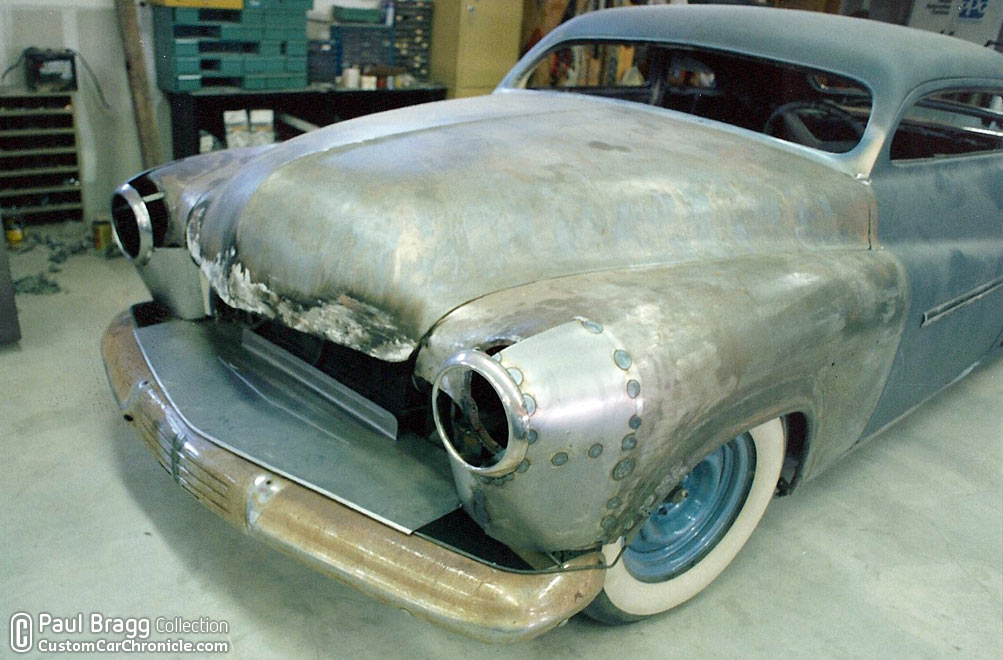 Half of the new shaped front section of the front fenders is in place now.
Half of the new shaped front section of the front fenders is in place now.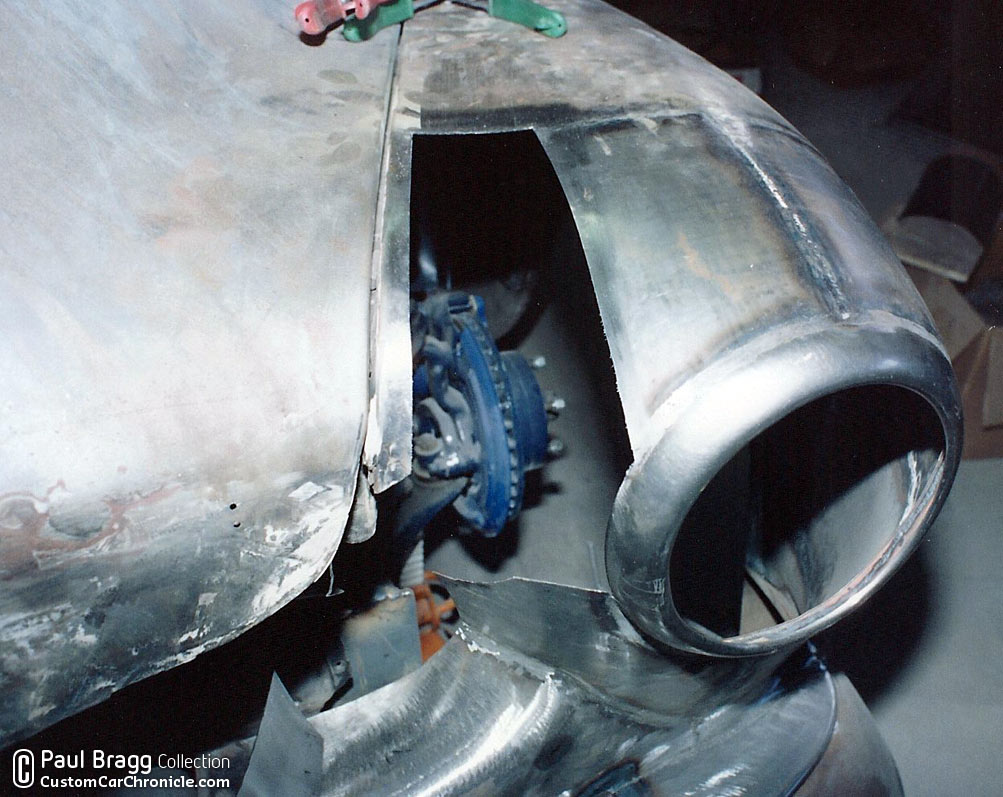 All body work on the mercury was hammer welded and metal finished.
All body work on the mercury was hammer welded and metal finished.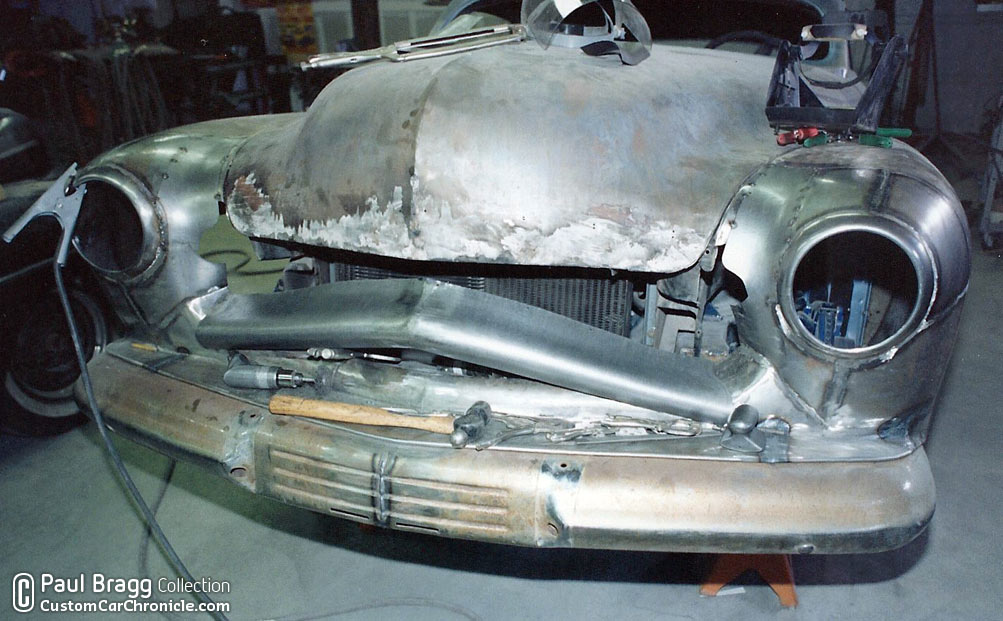 With
the work on the extended fenders done it was time to start shaping the
new grille opening. In this photo the bottom portion is already welded
in place. The top portion is shaped, but not in place yet.
With
the work on the extended fenders done it was time to start shaping the
new grille opening. In this photo the bottom portion is already welded
in place. The top portion is shaped, but not in place yet.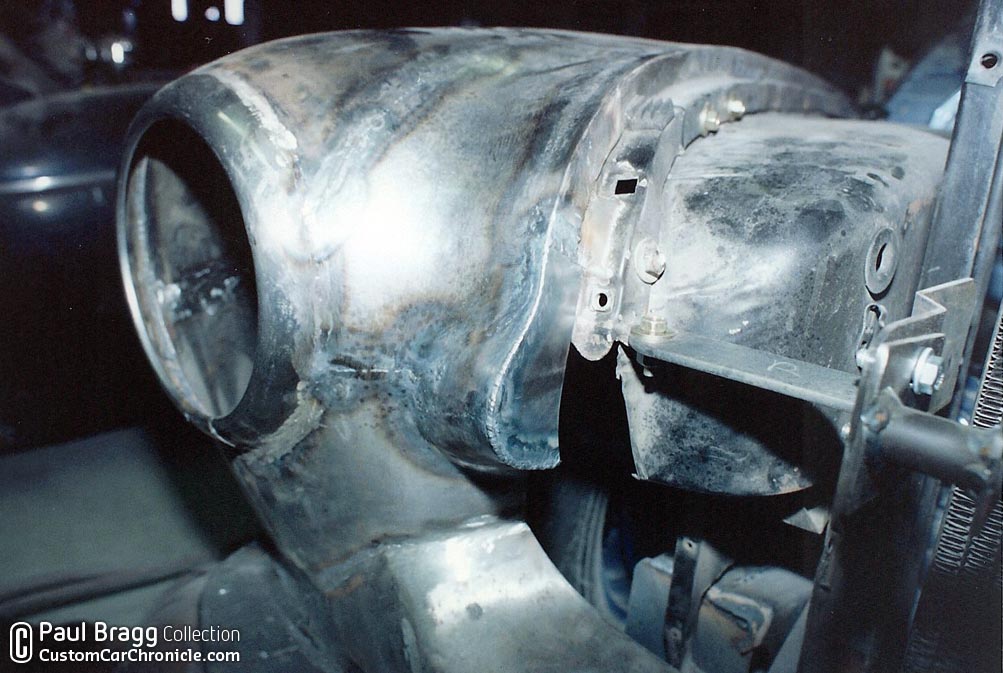 The top portion is now in place and the hood section is cut of and the ends filled in.
The top portion is now in place and the hood section is cut of and the ends filled in. The whole restyled front end is finished and now its time for lead and metal finish to perfection.
The whole restyled front end is finished and now its time for lead and metal finish to perfection. Leaded and sanded smooth. Notice the wonderful curves and shaped of the restyled elements.
Leaded and sanded smooth. Notice the wonderful curves and shaped of the restyled elements.
This photo shows the work done on the back side of the hood as well as the work on the rocker panels that flow into the lipped front wheel opening on the front and the scoop at the rear.
The finished car
After Paul Bragg’s work on Frank’s Mercury was finished and the car was in primer Frank took the car to Bill Reasoner in Walnut Creek, for the pearl aqua blue paint job Paul created a custom grille from bumper guards and 1953 Mercury bullets and customized a set of 1953 Cadillac hubcaps. After Bill Reasoner was done painting the car, Frank took the car to Jerry Sahagon for a custom interior.The Finished mercury is a great example of wonderful custom restyling. Basically no panel was left untouched to create this Paul Bragg masterpiece. It hints to the early Customizers Ayala and Barris brothers, but also incorporates Paul Bragg’s personal styling elements and modern details. The Paul Bragg Livingston Merc is a true masterpiece.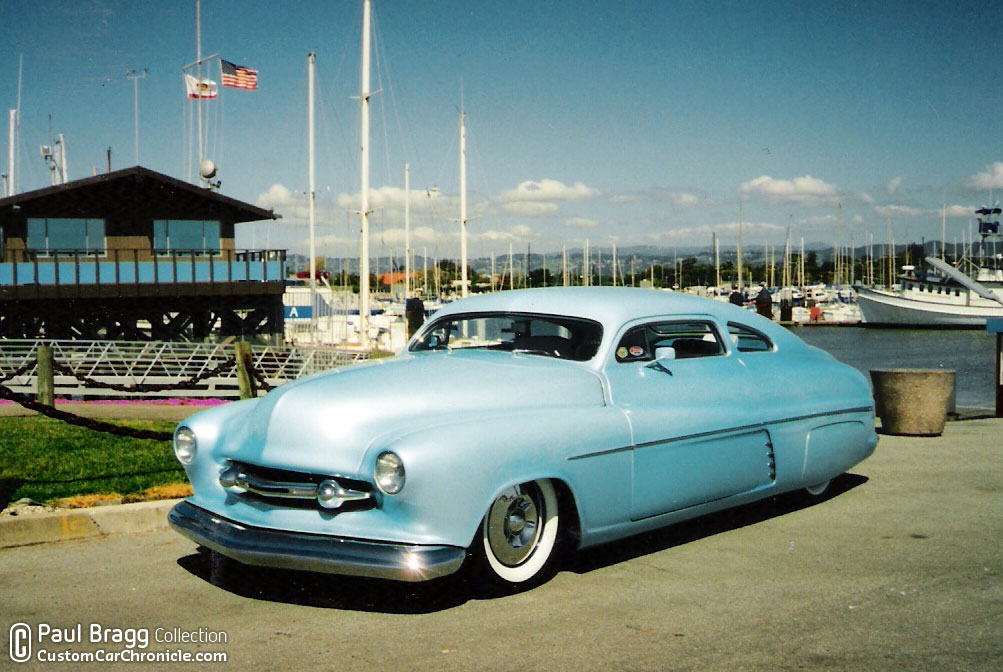 Paul
reshaped the ’51 Mercury front bumper by narrowing it to fit flush with
the fnders and adding a new center section created for a second ’51
Mercury bumper. The grille is a work of art in itself as well. (Frank Paul photo)
Paul
reshaped the ’51 Mercury front bumper by narrowing it to fit flush with
the fnders and adding a new center section created for a second ’51
Mercury bumper. The grille is a work of art in itself as well. (Frank Paul photo) The
flow of the new top, the reshaped rear quarter windows and angled
forward B-Pillars look particularly nice from this rear 3/4 angle. (Frank Paul photo)
The
flow of the new top, the reshaped rear quarter windows and angled
forward B-Pillars look particularly nice from this rear 3/4 angle. (Frank Paul photo) Paul even restyled the ’53 Cadillac hubcaps with custom made center sections. (Frank Paul photo)
Paul even restyled the ’53 Cadillac hubcaps with custom made center sections. (Frank Paul photo) A
good look at the rear of the car showed the wonderful reshaped ’51
Mercury front bumper and how its shape extends into the rear quarter
panels.This photo also shows how the lip of the front wheel opening
flows into the rocker panel.
A
good look at the rear of the car showed the wonderful reshaped ’51
Mercury front bumper and how its shape extends into the rear quarter
panels.This photo also shows how the lip of the front wheel opening
flows into the rocker panel. Everything on Frank’s Mercury flows and all the lines are there for a reason.
Everything on Frank’s Mercury flows and all the lines are there for a reason. The Mercury at the Sacramento Autorama where the car was a huge crowd pleaser.
The Mercury at the Sacramento Autorama where the car was a huge crowd pleaser.  Frank Livingston polishing and detailing the grille on set up day of the Sacramento Autorama.
Frank Livingston polishing and detailing the grille on set up day of the Sacramento Autorama. Source: customcarchronicles.com
Kevin Sledge Merc Is Finished
After driving his perfectly styled 1940 Mercury in suede for many years. Kevan Sledge debuted his finished 1940 Mercury at the 2014 Santa Maria WCK show.
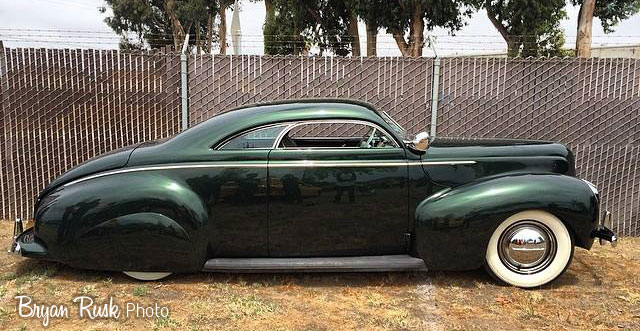
And now in 2014 Kevan has finally finished, or at least nearly finished his 1940 Mercury. There are still a few small details that need to be address. But still we can called his 1940 Mercury finished. We plan on doing an full article on Kevan’s mercury soon. But here are a few photos of the finished car and a fe from its long journey.
 Kevan’s Merc in black primer, plex mailslot windshield at Viva Las Vegas.
Kevan’s Merc in black primer, plex mailslot windshield at Viva Las Vegas.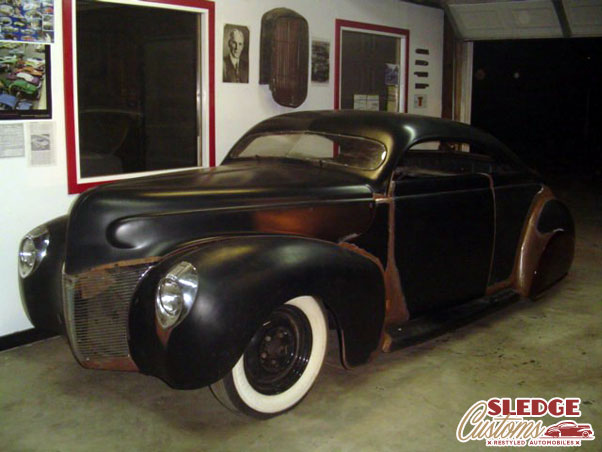 The Merc at King Kustoms workshop for some fine tuning work by Rob Radcliffe.
The Merc at King Kustoms workshop for some fine tuning work by Rob Radcliffe.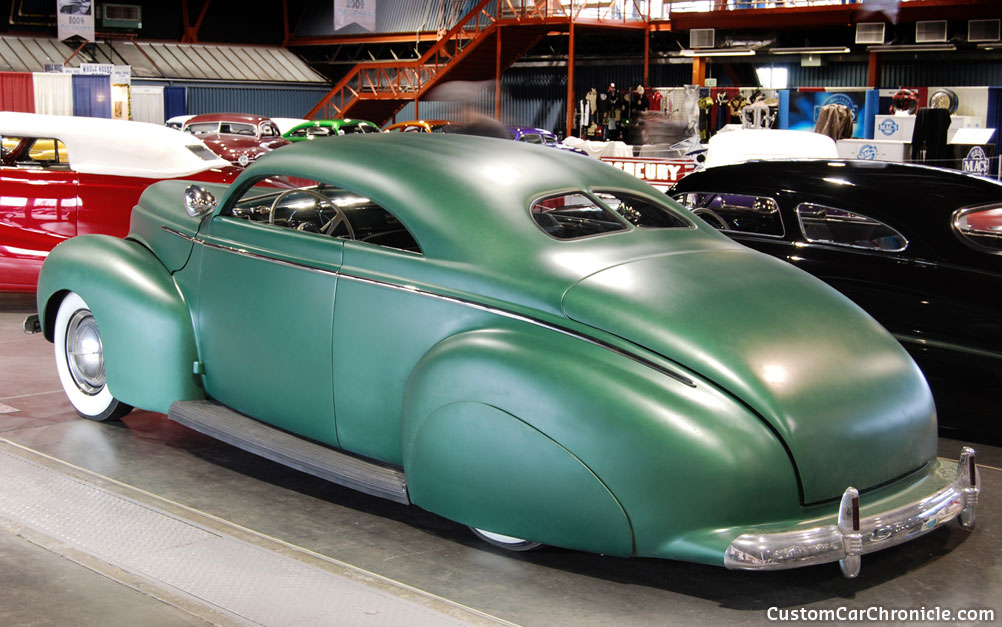 Kevan’s Mercury was invited to the prestigious Mercury Gathering at the 2009 Sacramento Autorama.
Kevan’s Mercury was invited to the prestigious Mercury Gathering at the 2009 Sacramento Autorama. In
November 2013, Kevan hired Rik Hoving Kustoms to visualize a few gloss
colors on his satin Merc. It was time for a deep geen glossy paintjob.
Here is one of the digital gloss color proposals.
In
November 2013, Kevan hired Rik Hoving Kustoms to visualize a few gloss
colors on his satin Merc. It was time for a deep geen glossy paintjob.
Here is one of the digital gloss color proposals. In the paint booth getting ready for the final color.
In the paint booth getting ready for the final color.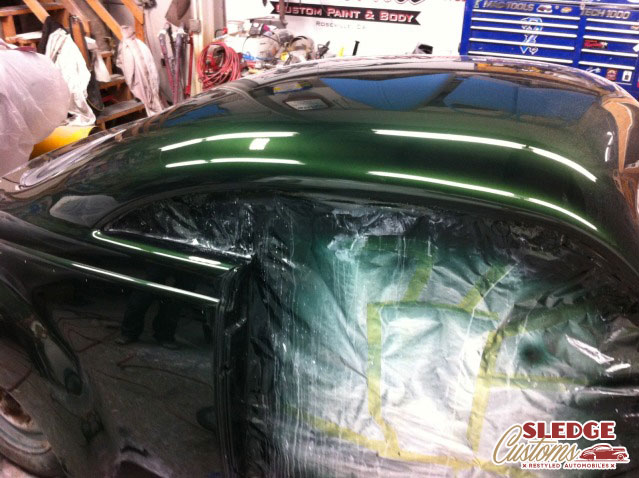 And we have color and shine.
And we have color and shine.
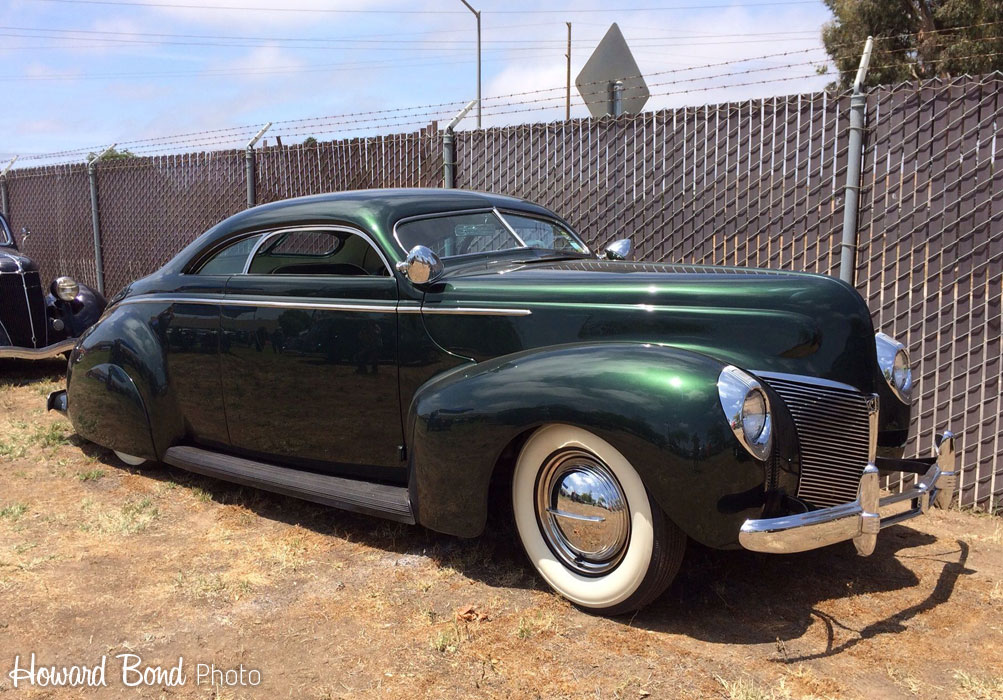 Howard Bond photo at the 2014,Santa Maria West Coast Kustoms show where Kevan debuted his finished Mercury. (May 24, 2014)
Howard Bond photo at the 2014,Santa Maria West Coast Kustoms show where Kevan debuted his finished Mercury. (May 24, 2014)

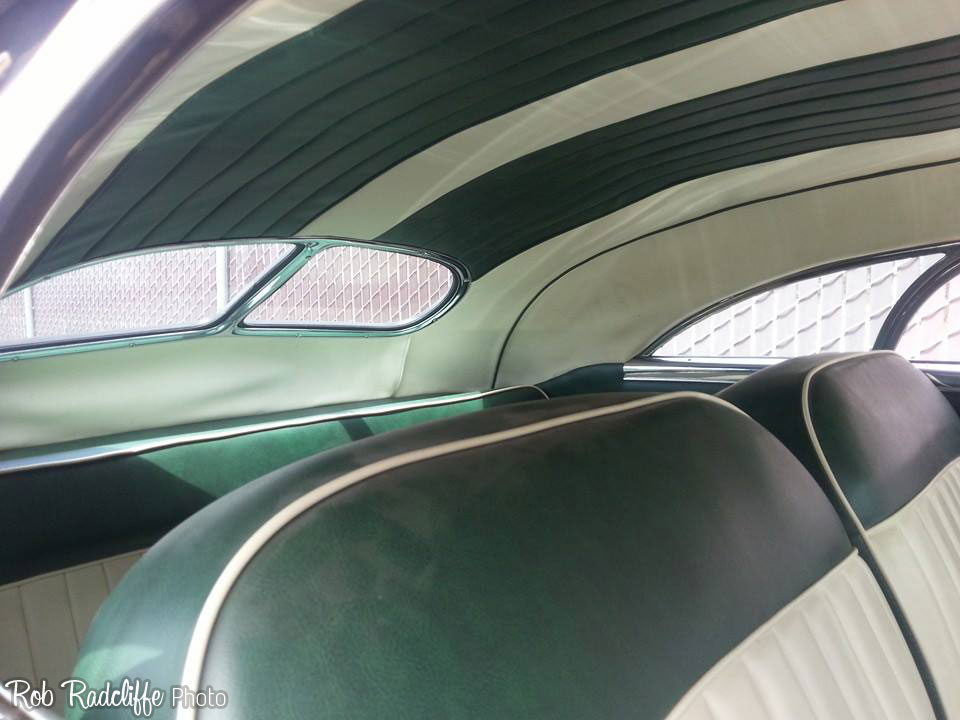
A few more photos of Kevan’s mercury an be seen in the CCC-Forum post on the West Coast Kustoms show in Santa Maria. Check it out HERE.
Source: customcarchronicle.com
Subscribe to:
Posts (Atom)
















